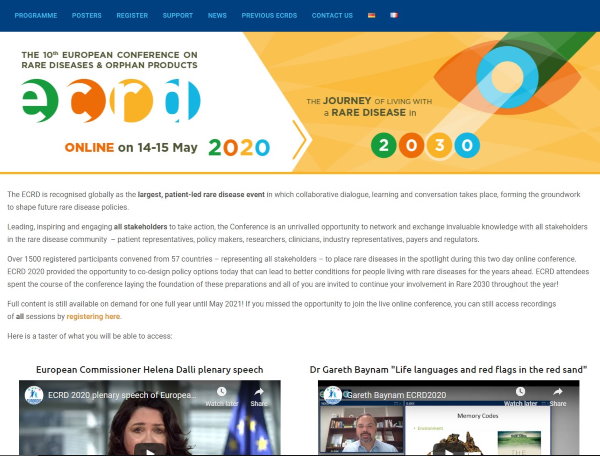Adrian Danek reports from 10th European Conference on Rare Diseases and Orphan Products (ECRD)
 |
The current situation has brought about new ways to meet and interact: very few people by now have not had their own experiences with virtual meetings. Among these was the 10th European Conference on Rare Diseases and Orphan Products (ECRD). I would not have been able to join an in-person convention in Stockholm but was able to participate in that my first virtual meeting thanks to the Advocacy. I was truly impressed by the introductory presentation of David Lega, a Swedish Member of the European Parliament (available also via https://www.youtube.com/watch?v=99G3emwDVzE&feature=youtu.be). Lega pointed out inequalities in allocation of educational and medical resources during the current health crisis and he warned that people with disabilities must not be forgotten in these difficult days.
The main emphasis of ECRD was not so much the detail of a single rare disease but what the commonalities are of these often neglected diseases so that they can attract the political attention for their specific social and medical needs. Among others, the current state of “Rare2030” was presented, a project to propose policy recommendations to the European parliament (www.rare2030.eu). Four basic scenarios were offered, dependent upon either more collective or more individual activity and whether innovation was more patient- or more market-led.
For many of us it was clearly fortunate that because of the global situation otherwise costly meetings at attractive yet not necessarily easy to reach destinations switched to the virtual format, too. Without leaving my desk and either fully free or at very low cost, I was able to profitably attend sessions of the European Academy of Neurology (https://www.ean.org/congress-2020) and the International Parkinson and Movement Disorder Society (https://www.mdscongress.org/) meetings as well as the 7th International Symposium on Neurodegeneration with Brain Iron Accumulation (NBIA) and Related Disorders (https://nbiascientificsymposium.org/), where I even presented a new family observation on the NBIA/neuroacanthocytosis overlap at a “flash session”. The main outcome is our participation in the MDSGene collaboration that aims to provide an internet information repository of individual gene mutations and the corresponding clinical findings (http://www.mdsgene.org/).
Informal, perhaps even “conspirative” talk as well as meeting and gathering with old and new acquaintances, however, does not happen and there is clearly a lack of the comraderie that is otherwise experienced during receptions and outings. Some virtual presentations suffer from the lack of rigor imposed by the atmosphere at a formal meeting, e.g. sitting in front of a laptop or standing at a lectern, and the attire expected. On the other hand, global communities are joined together in real time across day and night, across all time zones, and it is much easier to start chatting with an authority in the field than when these people are surrounded by their “courts” at a traditional evening social. Checking mails or jotting down new ideas during a not fully engaging lecture has become even easier than during the conventional meeting and the scrutiny of your colleagues´ living rooms or their diligently placed video backgrounds can offer some welcome distraction.
With the course of the global pandemic still fully unpredictable, it might not be an unwise decision to hold our 10th scientific meeting in 2021 in the virtual format. For the future we might think of switching biannually between in-person meetings (even years) and virtual neuroacanthocytosis symposia (uneven years). In the end, this should actually increase the cohesion of our community as well as scientific progress.

 |
|